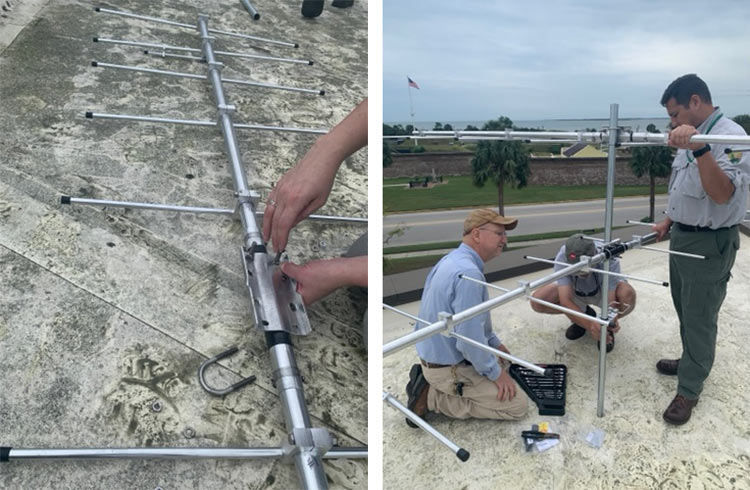
Audubon South Carolina and its partners, including Charleston Audubon, South Carolina Department of Natural Resources and the National Park Service, have coordinated to install a Motus tower at Fort Moultrie Visitor’s Center on Sullivan’s Island.
The wildlife tracking system is part of an international network of Motus towers that have been installed to more effectively track the movements and migratory patterns of birds and other wildlife, such as bats and butterflies. The Fort Moultrie tower is accessible to the public and will eventually include an interpretive sign.
To gain a better understanding of the full life cycles of vulnerable migratory species, the towers use radio telemetry to track wildlife migration.
Audubon South Carolina is collaborating with South Carolina DNR, Bird Studies Canada and other partners to create a network of towers via Audubon South Carolina Bird-Friendly Communities throughout the state.
The organization finds community partners to host the towers (e.g., Charleston Audubon is sponsoring the Fort Moultrie tower). The first tower to go live in Audubon South Carolina’s Motus tower network was sponsored by the Dewees Island Conservancy on Dewees Island, one of Audubon South Carolina’s Bird-Friendly Communities. Other towers that have been installed include those at Cape Romain, Kiawah, Edisto, Daufuskie Island, Harbor Island, Hunting Island and the Riverbanks Zoo in Columbia.
The idea is that a network of towers can trace a bird’s path more reliably, explained Jennifer Tyrrell, coordinator for Audubon South Carolina Bird-Friendly Communities. The project allows researchers to know where the birds are going and whether they are nesting or passing through, so conservation organizations can understand what habitats are most important for protecting.
South Carolina DNR works with Audubon South Carolina to coordinate technical assistance and biological background for the project.
Matthew King, a stewardship biologist with SC DNR who has been working with Tyrrell, said he does a lot of coastal stewardship, and the Motus tower network will raise awareness of the importance of South Carolina’s coast for shorebird migration.
The towers will provide valuable information on endangered and threatened species that stopover in South Carolina, including the piping plover and the itinerant red knot, which flies from pole to pole.
“It’s nice to educate and inform people that South Carolina’s beaches serve a very important biological niche,” noted King. “It’s important from a stewardship standpoint, but also from a research standpoint. It’s a worldwide collaboration of researchers.”
How do the towers work?
Radio telemetry uses radio signals and receivers to track birds and other wildlife. Tiny nanotag transmitters are temporarily attached to individuals (you can even put them on dragonflies) and the transmitters emit a signal that can be detected by the Motus tower antennae if a tagged individual flies within a few kilometers of it. Staging these towers along migration routes creates a virtual net to capture the animal’s information. The towers then connect to the internet and download tag ID numbers as they are retrieved in real-time, giving the researchers who deployed these tags the location of the bird as it migrates.
Motus towers allow bird and wildlife conservation experts to examine migration routes instantaneously without satellite transmitters. While satellite technology is a great way to track wildlife, it’s expensive and you cannot use tags on smaller birds. With banding, you need to band thousands of birds to successfully recapture a few individuals and gather information about that specific bird’s journey.
The towers make tracking wildlife more efficient and collaborative and less labor intensive, commented King. Now you can simply email data to fellow researchers.
Why should we care about tracking bird migration?
“Birds are a great indicator of environmental change. If they do vastly different things during migration, we know something is wrong,” stated King.
Tyrrell remarked that if we care about birds and want to protect them — for example, birds that breed here in South Carolina — we need to know about them throughout their entire life cycle.
By Colin McCandless

Leave a Reply